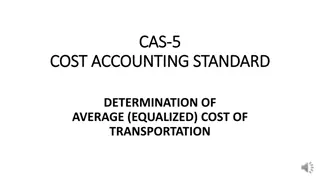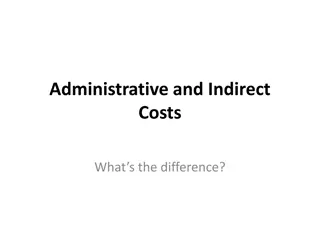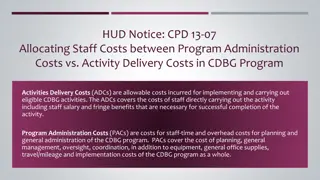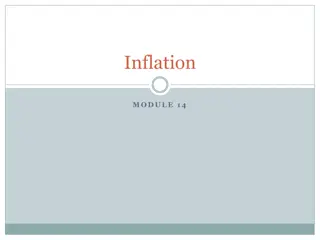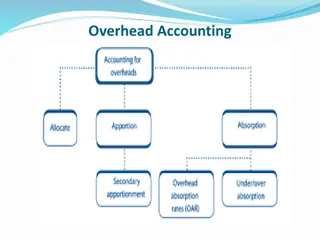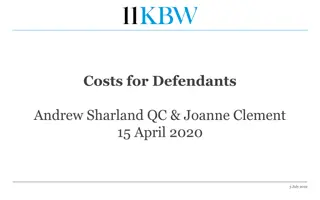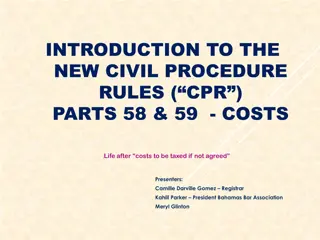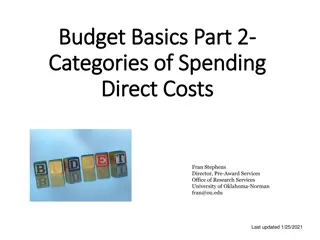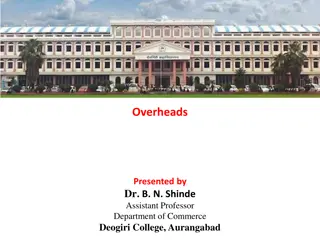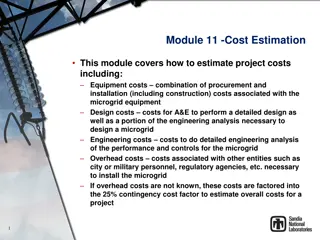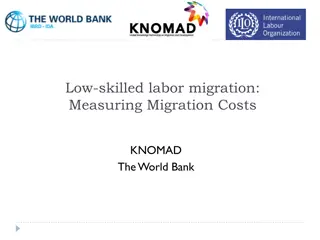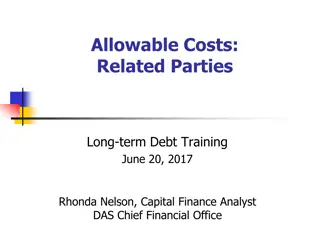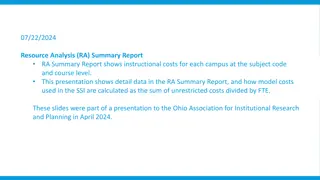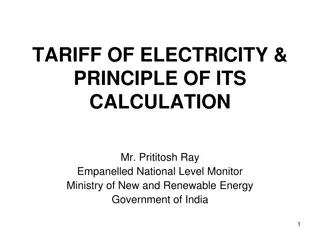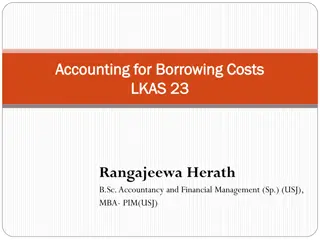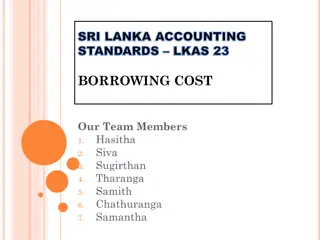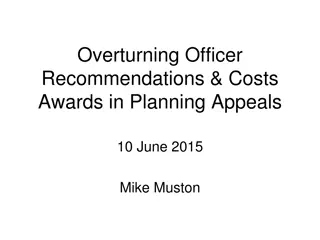Understanding Costs in Business: Types and Significance
Costs in business play a crucial role in determining profitability and decision-making. This article explores various types of costs such as direct, indirect, fixed, and variable costs, along with their definitions, uses, and impact on business operations. Understanding these costs is essential for effective pricing strategies, profit calculations, and overall financial management.
Download Presentation

Please find below an Image/Link to download the presentation.
The content on the website is provided AS IS for your information and personal use only. It may not be sold, licensed, or shared on other websites without obtaining consent from the author. Download presentation by click this link. If you encounter any issues during the download, it is possible that the publisher has removed the file from their server.
E N D
Presentation Transcript
Cost: A cost is an expenditure incurred by a firm to produce goods and services for sale in the market. In other words, a cost is the outflow of money from the business to gain inflow of money after sale of the commodity. A producer has to incur various costs in order to produce goods and services. These costs are of various types.
The following are the various types of costs:- Direct costs or explicit costs Indirect costs or implicit costs Fixed costs Variable costs Accounting costs Economic costs Total costs Average costs Marginal costs Opportunity costs 1. 2. 3. 4. 5. 6. 7. 8. 9. 10.
Direct cost or explicit cost: Explicit costs are those costs which are met by cash payments for employing various factors of production. The producer actually pays money to produce his goods and services. A direct or explicit cost is the material, labor, expenses, overheads, selling and distribution, administrative cost related to production of a commodity. It is accurate in nature. An explicit cost can be easily traceable. An explicit cost is defined as follows: An explicit cost is a direct expense that is paid in money to others or creditors during the production of goods. Uses of explicit costs: 1. It shows the expenditure incurred on production of the commodity which is considered for pricing strategy; 2. It also helps in calculating profits; 3. It helps in decision making
Indirect cost or implied cost: Implicit costs are those costs which the firm lets go or sacrifices in order to hire an alternative factor of production. These costs are opportunity costs of the factors of production. Implicit cost is also called as imputed cost. Here cash outflow does not happen. An implicit cost is defined as under: An implicit cost is the factor of production sacrificed by the producer for an alternative factor production. The opportunity foregone is the implicit cost. Uses of implicit cost: 1. It helps in decision making 2. It helps to ascertain opportunity costs 3. They directly impact profitability of the firm
Fixed costs: Fixed costs are those costs that do not change in the short run period of time. Fixed costs remain the same regardless of the amount of production and sale of commodities. These costs are incurred by the company irrespective of its production, i.e. even at zero production, the firm incurs fixed cost. A fixed cost can be defined as follows: A fixed cost is the cost that remains the same and fixed irrespective of the production of goods. Uses of fixed cost: 1. Useful in evaluating break even analysis; 2. Helps in pricing strategy; 3. Helps in decision making; 4. Helps in controlling variable costs
Variable Cost: A variable cost is that cost which changes in short run and long run time period. It always keeps on changing. These costs are incurred during production process and thus are the costs incurred for employing various factors of production. A fixed cost becomes a variable cost in the long run. A variable cost is defined as follows:- A variable cost is the expenditure incurred on the production of goods and therefore is ever changing. Uses of variable cost: 1. Helps to set prices for the commodity; 2. Helps to plan profits; 3. Helps in decision making; 4. Helps in cost control;
Accounting Costs: Accounting costs are those costs that a firm actually incurs. These costs are explicit costs. There is an actual expenditure which is kept in records for future reference. An accounting cost is defined as follows:- An accounting cost is the actual expenditure incurred by the producer in the course of business. These expenses also have a written record. Uses of accounting cost: 1. It shows the expenditure incurred on production of the commodity which is considered for pricing strategy; 2. It also helps in calculating profits; 3. It helps in decision making
Economic Costs: Economic costs are those costs that an entrepreneur incurs while conducting economic activities. For an entrepreneur an economic activity is his business. Therefore, economic costs include all the direct and indirect that the entrepreneur incurs while conducting business. An economic cost is the summation of explicit cost and implicit cost. An economic cost is defined as follows: An economic cost is the combination of direct and indirect costs that are incurred by the firm to produce commodities. Uses of economic cost: 1. It shows the expenditure incurred on production of the commodity which is considered for pricing strategy; 2. It also helps in calculating profits; 3. It helps in decision making; 4. It helps in decision making 5. It helps to ascertain opportunity costs 6. They directly impact profitability of the firm
Total cost: Total cost is the total expenditure incurred by the producer to produce his goods. Total cost is also the summation of total fixed costs and total variable costs. Total cost is evaluated as follows:- 1. Total Cost = Cost per unit x Quantity Produced 2. Total Cost = Total Fixed Cost (TFC) + Total Variable Cost (TVC) Total cost is defined as follows: Total cost is the cost which is incurred by the producer to produce a particular quantity of the commodity. Uses of total cost: 1. Helps in economies of scale as a producer needs large amount of raw materials for large production; 2. Helps in pricing policy; Helps in decision making;
Average Cost: An average cost is the expenditure incurred by the producer, for producing each unit of the products. An average cost is the per unit expenditure of the producer. Average cost is also the summation of average fixed cost and average variable cost. Average cost is evaluated as follows:- 1. Average cost = Total Cost /Quantity produced 2. Average cost = Average fixed cost (AFC) + Average variable cost (AVC) Average cost is defined as follows:- Average cost is the expense incurred by the producer to produce one unit of the total production. Uses of average cost: 1. Helps to cut down excess expenditure, as per unit cost is calculated; 2. Helps in optimum utilization of resources; 3. Helps in pricing strategy.
Marginal cost: Marginal cost is the expenditure incurred by the producer to produce an additional or an extra unit of the commodity. Marginal cost is the additional cost incurred for producing one extra unit after producing certain amount of units. MCn = TCn TCn-1 Marginal cost is defined as follows: Marginal cost is the cost or expense incurred for producing an additional or an extra unit of a commodity. Uses of marginal cost: 1. Helps in decision making 2. Helps to determine costs for each commodity 3. Helps in planning profits.
Opportunity Cost: An opportunity cost is the opportunity or choice that is let go off or sacrificed for an alternative choice. In economics, opportunity cost is the foregone production factor production factor. An opportunity cost is defined as follows:- An opportunity cost in business is the sacrificed option or factor of production for an alternative option or factor of production. Uses of opportunity cost: 1. Helps in optimum utilization of business resources; 2. Helps in decision making; 3. Helps in cost control. in business for an alternative


